2010 GMC SAVANA airbag
[x] Cancel search: airbagPage 1 of 424

In Brief........................................................... 1-1
Instrument Panel
........................................ 1-2
Initial Drive Information
............................... 1-4
Vehicle Features
......................................1-13
Performance and Maintenance
...................1-16
Seats and Restraint System............................. 2-1
Head Restraints
......................................... 2-2
Front Seats
............................................... 2-2
Rear Seats
............................................... 2-6
Safety Belts
.............................................2-10
Child Restraints
.......................................2-30
Airbag System
.........................................2-60
Restraint System Check
............................2-79
Features and Controls..................................... 3-1
Keys
........................................................ 3-3
Doors and Locks
....................................... 3-8
Windows
.................................................3-16
Theft-Deterrent Systems
............................3-20
Starting and Operating Your Vehicle
...........3-22
Mirrors
....................................................3-40
Storage Areas
.........................................3-42Instrument Panel............................................. 4-1
Instrument Panel Overview
.......................... 4-3
Climate Controls
......................................4-15
Warning Lights, Gages, and Indicators
........4-20
Driver Information Center (DIC)
..................4-37
Audio System(s)
.......................................4-59
Driving Your Vehicle....................................... 5-1
Your Driving, the Road, and the Vehicle
....... 5-2
Towing
...................................................5-22
Service and Appearance Care.......................... 6-1
Service
..................................................... 6-3
Fuel
......................................................... 6-5
Checking Things Under the Hood
...............6-12
All-Wheel Drive
........................................6-45
Rear Axle
...............................................6-46
Front Axle
...............................................6-46
Noise Control System
...............................6-47
Bulb Replacement
....................................6-48
Windshield Wiper Blade Replacement
.........6-54
Tires
......................................................6-55
Appearance Care
.....................................6-96
2010 GMC Savana Owner ManualM
Page 4 of 424

Safety Warnings and Symbols
Warning Messages found on vehicle labels and in this
manual describe hazards and what to do to avoid
or reduce them.
Dangerindicates a hazard with a high level of risk
which will result in serious injury or death.
WarningorCautionindicates a hazard that could result
in injury or death.
{WARNING:
These mean there is something that could hurt
you or other people.
Notice:This means there is something that could
result in property or vehicle damage. This would not
be covered by the vehicle’s warranty.
A circle with a slash
through it is a safety
symbol which means “Do
Not,” “Do not do this,”
or “Do not let this happen.”
Vehicle Symbols
The vehicle has components and labels that use
symbols instead of text. Symbols are shown along with
the text describing the operation or information
relating to a specific component, control, message,
gage, or indicator.
M:This symbol is shown when you need to see your
owner manual for additional instructions or information.
*:This symbol is shown when you need to see a
service manual for additional instructions or information.
Vehicle Symbol Chart
Here are some additional symbols that may be found on
the vehicle and what they mean. For more information
on the symbol, refer to the index.
9:Airbag Readiness Light
#:Air Conditioning
!:Antilock Brake System (ABS)
g:Audio Steering Wheel Controls or OnStar®
$:Brake System Warning Light
":Charging System
iv
Page 7 of 424
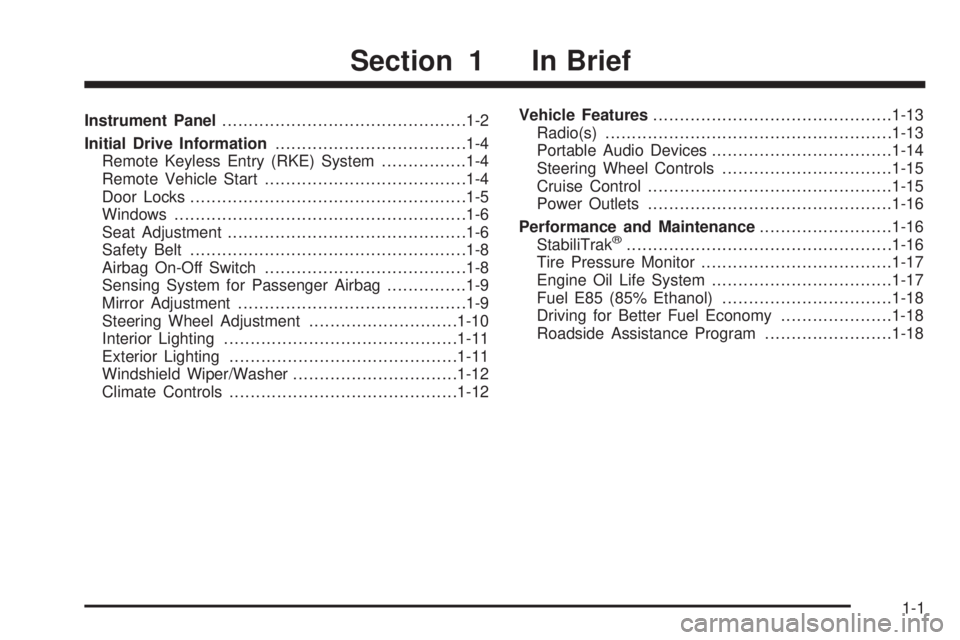
Instrument Panel..............................................1-2
Initial Drive Information....................................1-4
Remote Keyless Entry (RKE) System................1-4
Remote Vehicle Start......................................1-4
Door Locks....................................................1-5
Windows.......................................................1-6
Seat Adjustment.............................................1-6
Safety Belt....................................................1-8
Airbag On-Off Switch......................................1-8
Sensing System for Passenger Airbag...............1-9
Mirror Adjustment...........................................1-9
Steering Wheel Adjustment............................1-10
Interior Lighting............................................1-11
Exterior Lighting...........................................1-11
Windshield Wiper/Washer...............................1-12
Climate Controls...........................................1-12Vehicle Features.............................................1-13
Radio(s)......................................................1-13
Portable Audio Devices..................................1-14
Steering Wheel Controls................................1-15
Cruise Control..............................................1-15
Power Outlets..............................................1-16
Performance and Maintenance.........................1-16
StabiliTrak
®..................................................1-16
Tire Pressure Monitor....................................1-17
Engine Oil Life System..................................1-17
Fuel E85 (85% Ethanol)................................1-18
Driving for Better Fuel Economy.....................1-18
Roadside Assistance Program........................1-18
Section 1 In Brief
1-1
Page 9 of 424

A.Outlet Adjustment on page 4-17.
B.Driver Information Center (DIC) on page 4-37.
C.Turn Signal/Multifunction Lever on page 4-4.
D.Hazard Warning Flashers on page 4-3.
E.Instrument Panel Cluster on page 4-21.
F. Shift Lever. SeeStarting the Engine on page 3-23.
G.Climate Control System on page 4-15.
H.Audio System(s) on page 4-59.
I.Exterior Lamps on page 4-9.
J.Instrument Panel Brightness on page 4-12.
K.Cruise Control on page 4-6. Fast Idle System
(If Equipped). See Duramax Diesel Manual for more
information.L.Tilt Wheel on page 4-3.
M.Horn on page 4-3.
N.Audio Steering Wheel Controls on page 4-77.
O. Tow/Haul Mode Button. See “Tow/Haul Mode” under
Towing a Trailer on page 5-26.
P.Accessory Power Outlet(s) on page 4-14.
Q.StabiliTrak
®System on page 5-5(If Equipped).
R.Airbag Off Switch on page 2-69.
S.Storage Areas on page 3-42.
T.Passenger Airbag Status Indicator on page 4-26.
U.Rear Heating System on page 4-18(If Equipped).
1-3
Page 14 of 424
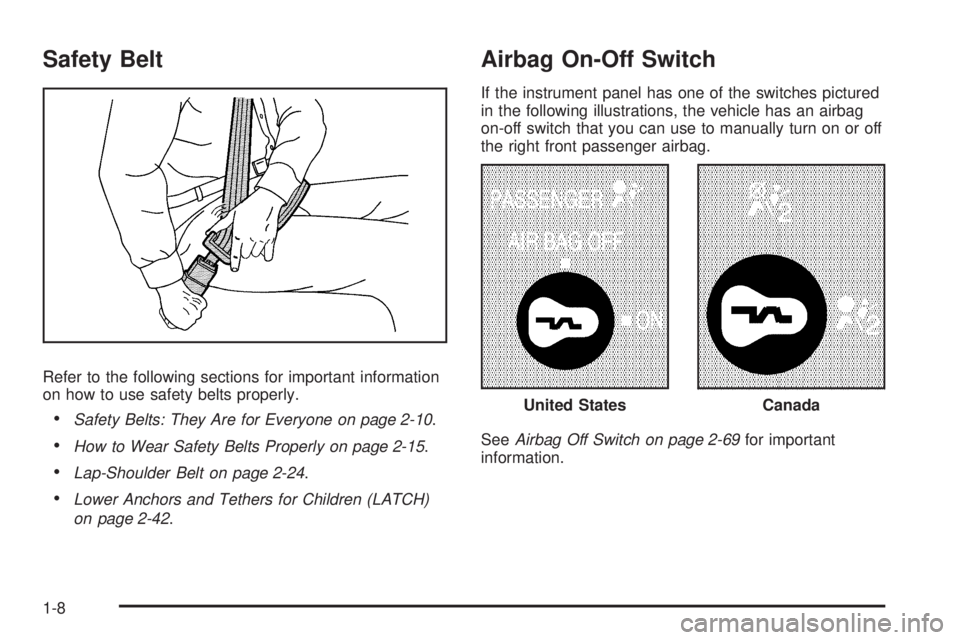
Safety Belt
Refer to the following sections for important information
on how to use safety belts properly.
•Safety Belts: They Are for Everyone on page 2-10.
•How to Wear Safety Belts Properly on page 2-15.
•Lap-Shoulder Belt on page 2-24.
•Lower Anchors and Tethers for Children (LATCH)
on page 2-42.
Airbag On-Off Switch
If the instrument panel has one of the switches pictured
in the following illustrations, the vehicle has an airbag
on-off switch that you can use to manually turn on or off
the right front passenger airbag.
SeeAirbag Off Switch on page 2-69for important
information.
United StatesCanada
1-8
Page 15 of 424
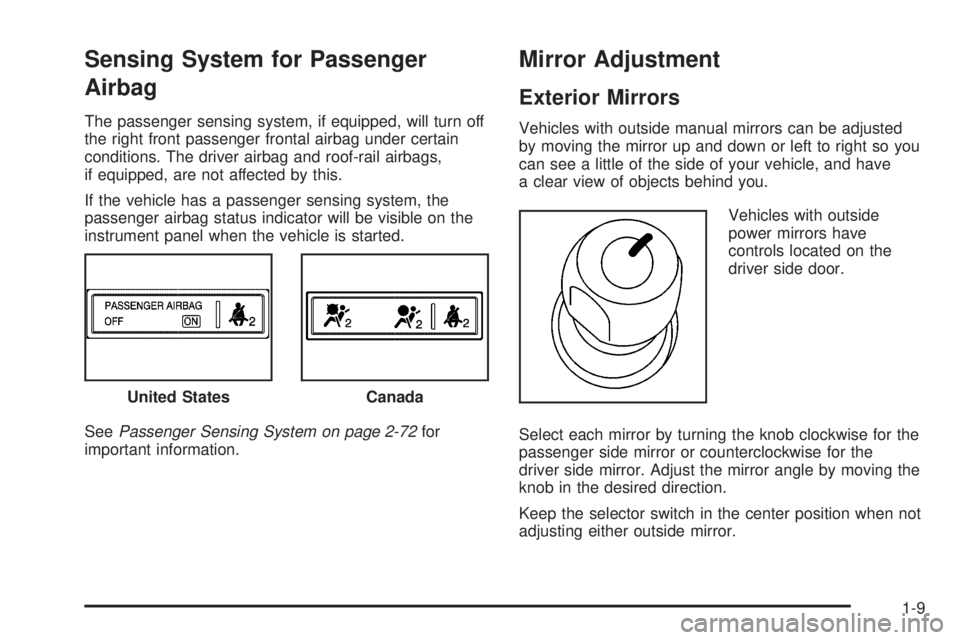
Sensing System for Passenger
Airbag
The passenger sensing system, if equipped, will turn off
the right front passenger frontal airbag under certain
conditions. The driver airbag and roof-rail airbags,
if equipped, are not affected by this.
If the vehicle has a passenger sensing system, the
passenger airbag status indicator will be visible on the
instrument panel when the vehicle is started.
SeePassenger Sensing System on page 2-72for
important information.
Mirror Adjustment
Exterior Mirrors
Vehicles with outside manual mirrors can be adjusted
by moving the mirror up and down or left to right so you
can see a little of the side of your vehicle, and have
a clear view of objects behind you.
Vehicles with outside
power mirrors have
controls located on the
driver side door.
Select each mirror by turning the knob clockwise for the
passenger side mirror or counterclockwise for the
driver side mirror. Adjust the mirror angle by moving the
knob in the desired direction.
Keep the selector switch in the center position when not
adjusting either outside mirror. United States
Canada
1-9
Page 25 of 424
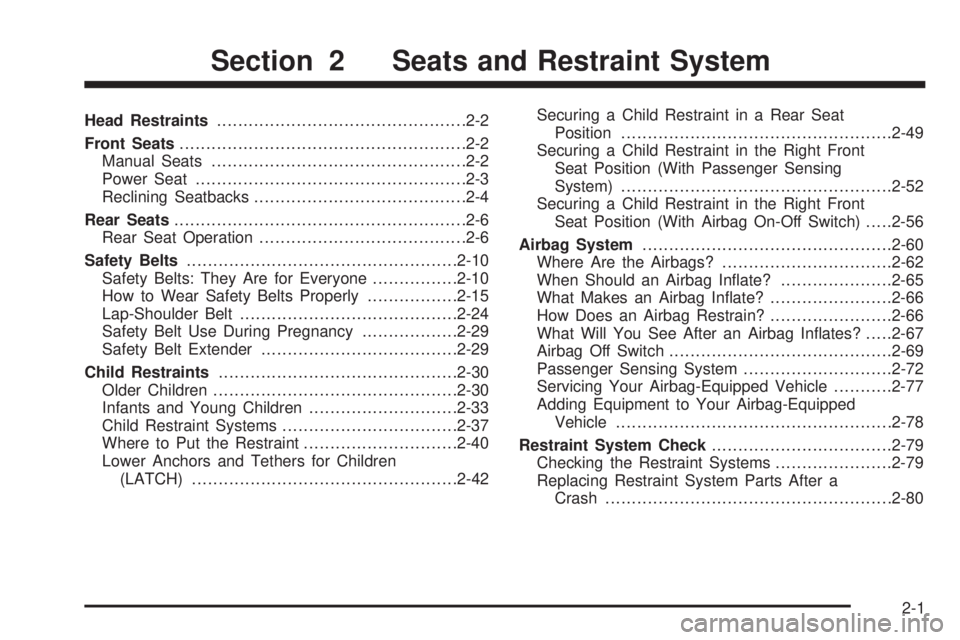
Head Restraints...............................................2-2
Front Seats......................................................2-2
Manual Seats................................................2-2
Power Seat...................................................2-3
Reclining Seatbacks........................................2-4
Rear Seats.......................................................2-6
Rear Seat Operation.......................................2-6
Safety Belts...................................................2-10
Safety Belts: They Are for Everyone................2-10
How to Wear Safety Belts Properly.................2-15
Lap-Shoulder Belt.........................................2-24
Safety Belt Use During Pregnancy..................2-29
Safety Belt Extender.....................................2-29
Child Restraints.............................................2-30
Older Children..............................................2-30
Infants and Young Children............................2-33
Child Restraint Systems.................................2-37
Where to Put the Restraint.............................2-40
Lower Anchors and Tethers for Children
(LATCH)..................................................2-42Securing a Child Restraint in a Rear Seat
Position...................................................2-49
Securing a Child Restraint in the Right Front
Seat Position (With Passenger Sensing
System)...................................................2-52
Securing a Child Restraint in the Right Front
Seat Position (With Airbag On-Off Switch).....2-56
Airbag System...............................................2-60
Where Are the Airbags?................................2-62
When Should an Airbag Inflate?.....................2-65
What Makes an Airbag Inflate?.......................2-66
How Does an Airbag Restrain?.......................2-66
What Will You See After an Airbag Inflates?.....2-67
Airbag Off Switch..........................................2-69
Passenger Sensing System............................2-72
Servicing Your Airbag-Equipped Vehicle...........2-77
Adding Equipment to Your Airbag-Equipped
Vehicle....................................................2-78
Restraint System Check..................................2-79
Checking the Restraint Systems......................2-79
Replacing Restraint System Parts After a
Crash......................................................2-80
Section 2 Seats and Restraint System
2-1
Page 38 of 424
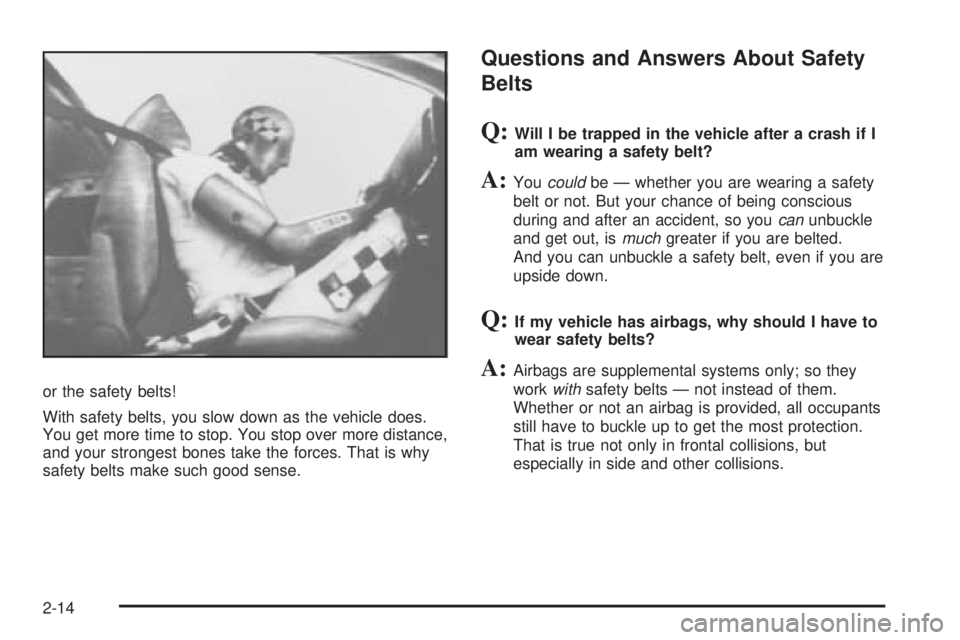
or the safety belts!
With safety belts, you slow down as the vehicle does.
You get more time to stop. You stop over more distance,
and your strongest bones take the forces. That is why
safety belts make such good sense.
Questions and Answers About Safety
Belts
Q:Will I be trapped in the vehicle after a crash if I
am wearing a safety belt?
A:Youcouldbe — whether you are wearing a safety
belt or not. But your chance of being conscious
during and after an accident, so youcanunbuckle
and get out, ismuchgreater if you are belted.
And you can unbuckle a safety belt, even if you are
upside down.
Q:If my vehicle has airbags, why should I have to
wear safety belts?
A:Airbags are supplemental systems only; so they
workwithsafety belts — not instead of them.
Whether or not an airbag is provided, all occupants
still have to buckle up to get the most protection.
That is true not only in frontal collisions, but
especially in side and other collisions.
2-14